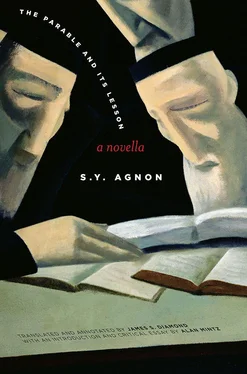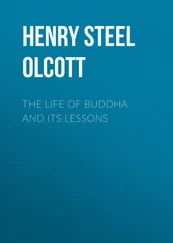As the ceremony proceeds, this extended scene comes to focus exclusively on the Rabbi, almost as if, in cinematographic terms, he were the subject of an extreme close-up. The Rabbi, we already well know, is the object of the shamash’s veneration, and it is therefore no wonder that his every gesture and utterance is taken to be infinitely meaningful. But the choice to place at the center of the scene a man so wholly absorbed in the reality of the martyred Jews is the sign of a broader narrative strategy intended to expose the depths of the trauma left in the wake of 1648. The Rabbi takes the prerogative of beginning with special memorial prayers for his own teacher, Rabbi Yeḥiel Mikhl of Nemirov, but he soon undergoes a breakdown. He bursts into tears, lays down the Torah scroll and places his head on the scroll. The object of fascination for the shamash and other observers in the congregation is the rabbi’s hair. Since receiving a wound to his skull during the massacres, he has not cut his hair, and his face is wreathed with a profusion of silver curls. Rather than attending to the grief that has momentarily disabled him, observers prefer a more transfiguring interpretation.
After a while he pulled himself up, and his white earlocks shone like polished silver. The interpreters of mystic secrets said that our Master had bathed his head in the waters of grace. His face shone in the crimson glow of the setting sun, but his eyes were closed, and our Master seemed like one who had been on a distant journey. Those same commentators said that he had returned from the far western edge of the world, where the Divine Presence resides, and there he had seen his Master, that holy light Rabbi Mikhl of Nemirov, and all the martyrs with him, sitting in the Academy on High, radiant in the Divine Presence. I do not concern myself with hidden matters — for a person like me what my eyes behold is sufficient — but I agree with those who say that every single one of our Master’s curls resembled a silver goblet that has been immersed in pure water. (41)
On the face of things, the kabbalistically attuned observers in the congregation would seem to be merely amplifying the shamash’s reverential stance toward the Rabbi. But the mystical ascent they ascribe to him, together with its happy vision of the martyrs basking in God’s presence, functions to evade the anguish and bereavement that are the dominant and proper emotions of the moment and the ones that the Rabbi’s breakdown truly expresses. Even the shamash, who, with his customary skeptical humility, distances himself from the transfiguring extremes proposed by the mystically inclined, is willing to permit a resemblance between the curls and the silver goblet immersed in pure water. The irony is that the Rabbi is indeed momentarily lost in another world, but it is the world of grief, not mystical transport. He recovers and regains control not once but twice, and with his commanding spiritual authority he proceeds to conduct the memorial service, so laden with complex liturgical poems, unflinchingly toward the goal of remembering the dead. The liturgy of that lengthening day, one of the longest days in the calendar, has a number of crescendos, and we shall return to the final parables that give the story its name. Surely one of those heightened moments reflects how the events of 1648 have impressed themselves on his mind: “He recited the names of the towns and villages that had been destroyed, and there was not one town or hamlet that he did not mention, and there was not one community of which he did not enumerate the number of Jews killed in it” (44). It is the tragic, epic and — certainly from the point of view of mental acuity — dazzling recitation of the names of the lost communities that demonstrates not only the abiding vigor of his mind but also the oceanic dimensions of the catastrophe.
GEHINNOM
When it comes to the sensational scenes in the Netherworld, it is important to keep in mind that the shamash’s narrative has at least two audiences: within the framework of the story there are the town elders assembled to judge him for his infraction, and outside it there are modern readers reading the story when it first appeared in Haaretz in 1958 or when it later appeared as part of ‘Ir umelo’ah . (One can also speak of an ideal implied audience created by the expectations of the pious narrator in the act of telling the story; that theoretical construct will be put aside for the present.) The responses of these two audiences to the scenes in Gehinnom are, unsurprisingly, likely to be very different. As modern readers, we have a variety of filters and rubrics through which we might make sense of depictions of grotesque punishments in the afterlife that are foreign to our sensibilities. We can choose to view them as literature rather than theology. When I was required to read Dante’s Divine Comedy as a freshman in college — the relevance of this particular example will be evident shortly — the poem was presented as a sublime integration of the social, scientific and political ideas of the Renaissance written within the idiom of the contemporary Christian religious imagination. This is an example of just one of the many ways in which we recuperate religiously exotic material by “appreciating” it rather than feeling called on to accept or reject the credal demands it makes on us. We are likely to respond to the Gehinnom scenes in Hamashal vehanimshal with a similar mixture of fascination and curiosity. In fact, the more fantastic and grotesque, the greater our fascination and curiosity.
The reaction of the listeners within the story is quite otherwise. They are shaken to the core, as was the shamash fifty-four years ago when he underwent the experience and as he now relives it. They are deeply disturbed because his eyewitness account contradicts essential elements of their beliefs about the afterlife. As Galician Jews living at the end of the seventeenth century, they are profoundly anxious about the fate that awaits them after death, and their absorption in imagining the afterlife, it needs hardly be said, has little to do with literary or anthropological fascination. The learned Jews depicted in the story were living at a time in which there had recently been a dramatic expansion in imagining the fate of the body and soul after death. Historians have long emphasized the fact that a belief in an afterlife became an official part of the religion of the Jews only after the biblical period. The rabbis of the Talmud authorized the existence of a postmortem Gehinnom (Hell) and Gan Eden (Paradise) and promulgated a doctrine of resurrection and tied them together with a belief in a messianic redemption at the end of history. Yet despite their insistence on the credal status of these beliefs, which were made into an integral part of the daily and Sabbath liturgy, the Rabbis discouraged speculation on these matters and provided tantalizingly little concrete information about what would happen in the afterlife. In the Middle Ages, this vacuum was abhorred by some and reaffirmed by others. Maimonides seconded the belief in resurrection, but only after discouraging speculation about it and only with the provision that it is solely the intellect that survives death and not the body. In contrast to this philosophical rationalism, the mystical tradition had no inhibitions about elaborately imagining the workings of the divine mysteries, whether they included the flow of divine energy within the Godhead or the abstruse geography of Hell.
The dissemination of kabbalistic ideas among Polish Jews intensified and broadened remarkably at the beginning of the seventeenth century. Meditation on divine mysteries, centered especially on the text of the Zohar, had long been a secret occupation of individual elite scholars. The theosophical innovations of Isaac Luria and his circle in Safed in the sixteenth century not only created a more applied and activist theology but also took an evangelizing stance toward promulgating that theology far beyond a narrow circle. Through their writings, Moses Cordovero and Isaiah Horowitz (known as the Shelah Hakadosh) restated Luria’s ideas in an approachable form and integrated them into familiar genres of ethical and pietistic guides. In this fashion, teachings that had been limited to an esoteric group of Sephardi mystics in the East were transferred to Polish Jews over the course of the seventeenth century and, in more domesticated and exoteric guise, became an essential part of everyday piety. Within this new framework, the religious imagination was liberated when it came to the afterlife, amply filling in the gaps left by the laconic restraint of the sages of the talmudic period. A good place to find these new imaginings about the afterlife gathered together is the Reishit ḥokhmah , a widely popular and oft-reprinted compendium of ethical teachings by Elijah de Vidas, a student of Cordovero’s, which first appeared in 1579. In chapter 13, de Vidas brings together texts bearing on the afterlife from the Talmud and the Zohar, as well as from Masekhet Gehinnom, a work of unknown provenance. 21
Читать дальше












![Edward Ellis - Adrift on the Pacific - A Boys [sic] Story of the Sea and its Perils](/books/753342/edward-ellis-adrift-on-the-pacific-a-boys-sic-s-thumb.webp)